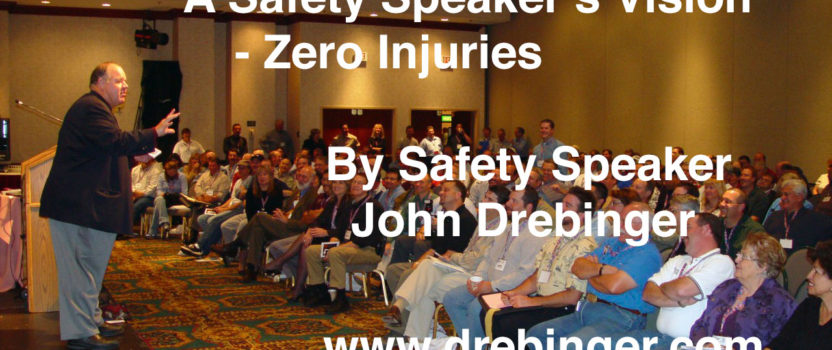A Safety Speakers Vision – Zero Injuries
Safety Speakers Vision
Safety speakers have some fun opportunities. Meeting you when I travel is one of them. Also the discussions safety speakers have with their audience after a presentation and through email help improve how we help people work safely. As a consultant, speaker and author, I really enjoy hearing from you, my readers. I recently received an email from someone who had read my book, “Mastering Safety Communication,” and they asked the following question:
“In school, I was taught, “0 Incidents/Accident Free” was always a poor goal/objective. One of the reasons was it would encourage lack of reporting for reasons such as “ruining the record” or having a negative reputation of failure. Lack of reporting may cause incidents not to be investigated and possibly lead to higher loss potential. My question is – when the message of “Accident Free” is communicated to a site, how do you encourage reporting a failure?”
First, as a communication specialist, I want to be clear word choice and usage does make a difference. Three words I would like to discuss are investigation, failure and goal.
Investigation vs. Analysis
Fellow safety speakers and I have pointed out the importance of language. When an injury occurs it is critical to discover the cause and more importantly, how to prevent it from ever happening again. When we refer to the study of an incident as an investigation we discourage people from giving us accurate information. Think about it; there is no use of the word investigation that is a happy situation. I can assure you, no one is ever pleased to find out they are being investigated by 20/20, the government, the police, etc. I suspect if you talked to the public relations people in your company they would tell you if any group approached you with an investigation, your proper reply would be, “No comment.”
After an injury, we want people’s input and comments. Instead of saying incident investigation say, “We are conducting an incident analysis.” The message communicated is much different and you will get a more open response.
Failure
In general, I do not use the word failure very often. When something goes wrong I consider it a success when I learn something that makes me better. It is critical to understand what the real failure is. For instance, when someone is injured we would think of that as a failure. I would suggest the failure occurred long before the injury. Where we failed was when we did not develop a procedure, safety guard, device or personal protective equipment that would have prevented the injury. Understanding this, we can take a look at what will prevent the next injury. It also takes the focus off the specific incident and gets to the root of the problem.
Zero or Injury-Free
To get to the crux of your main question we must all be committed to achieving an injury-free workplace. In fact, when I teach people how to watch out for the safety of others I don’t limit it to on-the-job; I include safety off-the-job and watching out for friends, family and people you see in public whom you may or may not know.
I can’t imagine a mindset that allows for the ultimate outcome of the safety profession to allow anyone to be injured. So how do we reconcile the value of aiming for zero and getting the true safety reporting we need to constantly make the workplace safer?
Zero Is a Vision
I agree having zero injuries as a measurable or accountable goal has many negative challenges. In my opinion, zero injuries is the vision everyone from the newest employee to the CEO of a corporation should have. I have had conversations with corporate leaders, who realizing their company had a line item in the budget for injuries, objected and insisted on it being removed. They felt it was immoral to “plan” on injuring people.
ExxonMobil has had the slogan, “Nobody Gets Hurt” for many years. Nobody means zero.
I love one executive’s comment who spoke before me. They said in celebrating a 50% drop in injuries from the previous year (9 from 18), “Last year we had our best year ever… (Long thoughtful pause) Unless you were one of the nine people who were injured. For them, it was their worst year.”
Those organizations that have zero as their vision also spend a great deal of effort encouraging reporting of close calls and injuries. They would not tolerate a supervisor who encouraged under-reporting.
Leading Activities Should Be Your Measured Goal
The incentives, rewards and records are based on activities or behaviors that improve overall safety performance of the individual and the organization, which will result in fewer injuries. One company gave a $25 gas card or building supply card when an employee completed 10 of 15 activities marked on a card each quarter. The activities included among other things, doing a safety observation, attending a safety meeting, donating blood, serving on a safety committee, giving a safety tailgate briefing, etc. All of the activities were measurable and kept safety in the mind of each employee.
Goals Must Be Achievable by Individuals
Another key is that each employee can control their own destiny. One problem with the zero goal and any incentives or performance reviews being based upon them is that you can’t control the behavior of your fellow employees. You can encourage them but you can’t do much if they choose to practice unsafe behaviors.
Negative Consequences of Zero as a Goal
Some results of having zero as the goal or job performance standard are surprising. I have had conversations with safety professionals that shocked me at the time.
One that comes to mind from over 15 years ago was someone who was bragging they had gone 4 million worker hours without a lost-time injury. At first, that sounds impressive. In discussing this across a table at a conference, the person said they almost didn’t make it to the 4 million last year. Curious, I asked, “What happened?”
The answer left me speechless. The person explained one of their workers was injured but because they had corrective surgery during their vacation it didn’t count as a lost-time accident. Wow, I realized everyone at their facility knew that the 4 million was a fraud. I wondered what other injuries were covered up by some technicality.
Zero as a Constantly Improving Vision
Zero as a vision is what everyone needs to look toward. It is also a vision that changes as a company improves their safety performance. When I began speaking 24 years ago many sites talked about achieving zero disabling injuries. In a few years, that changed to zero lost-time injuries, then on to reportable and recordable injuries. The great news is leaders with vision have moved the bar higher and higher. One company had such a successful on-the-job safety record they started keeping track of off-the-job injuries so they can continue to improve.
Watching Out For Others Moves You Toward Zero
As one of the most innovative safety speakers in the profession I can Imagine a workplace where everyone watches out for the safety of the people around them. You don’t have to imagine it. My audiences leave my presentation with a personal reason they want to watch out for the safety of others and with techniques they can use immediately. Contact my office today to find out the many ways we can help you help your people to watch out for the safety of others.
Until next week,
I’ll be, “Watching Out For Everyone’s Safety™”
John








